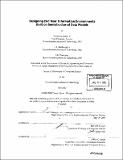| dc.contributor.advisor | David R. Karger. | en_US |
| dc.contributor.author | Quan, Dennis A. (Dennis Arthur), 1981- | en_US |
| dc.contributor.other | Massachusetts Institute of Technology. Dept. of Electrical Engineering and Computer Science. | en_US |
| dc.date.accessioned | 2006-03-24T16:22:02Z | |
| dc.date.available | 2006-03-24T16:22:02Z | |
| dc.date.copyright | 2003 | en_US |
| dc.date.issued | 2003 | en_US |
| dc.identifier.uri | http://hdl.handle.net/1721.1/29750 | |
| dc.description | Thesis (Ph. D.)--Massachusetts Institute of Technology, Dept. of Electrical Engineering and Computer Science, 2003. | en_US |
| dc.description | Includes bibliographical references (p. 206-214). | en_US |
| dc.description.abstract | Today's information systems were not built to adapt themselves to personal needs. For example, assigning properties not envisioned by the database administrator or the software engineer such as "good music to listen to when I am in a bad mood" or "excellent sushi place for taking foreign guests" is difficult in most programs because schemas are often cast in stone by a compiler or database management system. Relationships between objects in the same program or different programs, such as "Bob is Mary's brother" or "this report is relevant to next week's meeting", are similarly difficult to specify, since programs either fail to expose their object models to each other, or their object models are not fine-grained enough. If computers cannot record connective meta-data-the "glue" we use for keeping track of things-information overload will eventually prevent users from taking full advantage of information technology.We claim that by using a semistructured data model, the system can capture the context and circumstances underlying information and not simply the information itself and thus help to elucidate the relevance of the information for the user and others. To demonstrate the efficacy of our semistructured data model (based on semantic networks) and explore its consequences to the user interface, a system named Haystack has been built that permits users to store their information in a flexible fashion that can adapt to their needs. | en_US |
| dc.description.abstract | (cont.) Haystack also coalesces previously segregated sources of the user's information, describes the data found in these sources using our rich description framework, and explores new means and synergies for creating, displaying, and sharing this information. The thesis begins with a motivation of the problem space and a tour of our system and then delves into the details of our user interface paradigm and other higher level concepts we believe will be helpful for those designing future information environments. | en_US |
| dc.description.statementofresponsibility | by Dennis A. Quan, Jr. | en_US |
| dc.format.extent | 214 p. | en_US |
| dc.format.extent | 12331358 bytes | |
| dc.format.extent | 12331164 bytes | |
| dc.format.mimetype | application/pdf | |
| dc.format.mimetype | application/pdf | |
| dc.language.iso | eng | en_US |
| dc.publisher | Massachusetts Institute of Technology | en_US |
| dc.rights | M.I.T. theses are protected by copyright. They may be viewed from this source for any purpose, but reproduction or distribution in any format is prohibited without written permission. See provided URL for inquiries about permission. | en_US |
| dc.rights.uri | http://dspace.mit.edu/handle/1721.1/7582 | |
| dc.subject | Electrical Engineering and Computer Science. | en_US |
| dc.title | Designing end user information environments built on semistructured data models | en_US |
| dc.type | Thesis | en_US |
| dc.description.degree | Ph.D. | en_US |
| dc.contributor.department | Massachusetts Institute of Technology. Department of Electrical Engineering and Computer Science | |
| dc.identifier.oclc | 54404464 | en_US |
